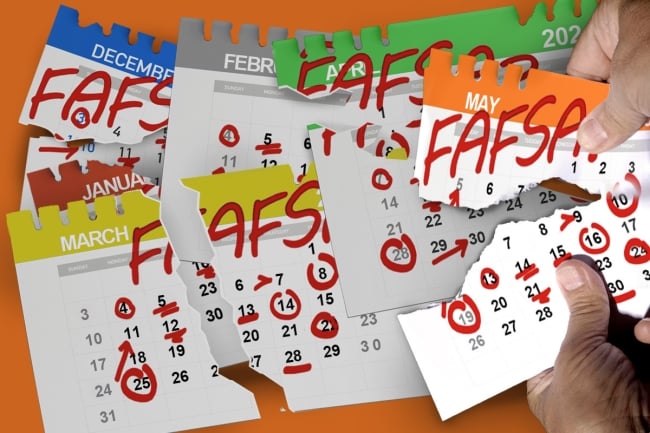You have /5 articles left.
Sign up for a free account or log in.

Student aid forms are finally being sent, but the slow pace and technical problems could further hamper an already troubled admissions cycle.
Photo illustration by Justin Morrison/Inside Higher Ed | Getty Images
The Department of Education began sending batches of student aid information to colleges last week, following through on the delayed and highly disruptive Free Application for Federal Student Aid (FAFSA) timeline it laid out in late January.
Yet while the department has finally turned on the tap, student aid forms—crucial for assembling accurate financial aid offers—are coming at a trickle.
Brian Ghanoo, associate vice president of student financial services at Fordham University, said they typically receive about 100,000 Institutional Student Information Records, or ISIRs, in a given cycle. So far, they’ve gotten three.
“It’s definitely fewer than we’d hoped for at this point,” he said. “Given the volume and the pace of the ramp-up, I really don’t see us getting everything in until the end of March, maybe early April. Then we need time to process, and we can’t do that in two weeks. The volume is just too high.”
The exact number of ISIRs received varies by institution, but the colleges that responded to Inside Higher Ed’s query all said the number has been paltry. As of Friday, the University of Michigan had received 18; the University of Maryland, Baltimore County, six; and Southwestern University in Texas, two; to give a small sample.
As of March 15, 5.8 million FAFSAs had been completed, according to an education department spokesperson. They did not name an expected date for the ISIR transmissions to be completed, but cautioned that any new forms submitted would take “about two additional weeks” to process. Typically, about 17 million FAFSAs are completed each year, according to federal student aid data.
The education department spokesperson said the delivery of processed ISIRs is “consistent with our announcement on January 30” that they would start going out in batches by mid-March.
“We are continuing to ramp up our operations to process applications, and as part of the ramp up the Department has begun delivering thousands of ISIRs across hundreds of schools,” the spokesperson wrote in an email to Inside Higher Ed.
Tom Delahunt, vice president for strategic recruitment and enrollment at Southwestern University, said he’s glad some progress is being made, but his experience since the troubled launch of the new FAFSA has eroded much of his faith in the department’s ability to follow through in a timely manner.
“I guess in some ways the department met their deadline; they started sending ISIRs. But we’ve only gotten two,” he said. “We want to get this wagon wheel rolling, and I’m hopeful, but I’m not naive. After so many starts and stops over the last four or five months, I’m a bit skeptical that this is really going to work as we’d like it to.”
Karen McCarthy, vice president of public policy and federal relations for the National Association of Student Financial Aid Administrators, said the slow pace has been a common trend among institutional members she’s heard from. That’s in part because the department is sending out ISIRs by applicant rather than by institution, meaning each student’s information goes to all the colleges they applied to instead of each college getting all their applicants’ forms at once.
“It’s been a batch here, a batch there … we really are in the ramping up stage,” she said. “The concerning thing is, there’s no clear indicator of when that will end and the processing can start.”
A Snail’s Pace
Justin Monk, director of student and institutional aid policy at the National Association of Independent Colleges and Universities, said, for many colleges, receiving even a few ISIRs is cause for celebration, given all the delays and missteps that have marked this year’s process.
“It’s a moment for many institutions when they can finally exhale after holding their breath for so long,” he said.
That relief is likely to be short-lived, McCarthy said. Most colleges are doing all they can to prepare, but the most important piece of the puzzle—the ISIRs themselves—has not yet clicked into place, and time is running short.
“I hate to be a negative Nelly here, but the work doesn’t end when the department sends out ISIRs,” she added. “That’s when 95 percent of the work starts on the college side.”
Aside from the slow pace, financial aid officers have been frustrated by a number of technical hang-ups that have plagued the start of ISIR transmissions—much like those that accompanied the department’s “soft launch” of the new FAFSA in late December, when the department met Congress’ Jan. 1 deadline but left a slew of unresolved problems that rendered the form practically unusable for over a week.
This time, the handful of ISIRs sent so far are, in many cases, useless; the software that financial aid officers use to receive and process them need to be updated to account for recent fluctuations in the Student Aid Index formula. Last month, an overlooked calculation error led the department to alter its formula slightly, which financial aid software vendors subsequently adjusted for. Less than a week later Congress undid those changes, and financial aid offices say their software vendors are still playing catch up.
Banner, a financial aid information exchange software used by over 1,400 institutions, will be updated and ready for use by March 21, according to multiple financial aid administrators. A spokesperson for Ellucian, Banner’s developer, did not respond to questions. PowerFAIDS, a similar platform provided by the College Board, is facing the same issue caused by the formula whiplash at the end of February, according to several financial aid officers at colleges that use the software. And issues with EdConnect, the education department’s own terminal for student aid information exchange with colleges, has required frequent updates in the past few weeks.
“There are many schools that have been getting ISIRs but can’t access them,” McCarthy said.
A department spokesperson said the Student Aid Index update “does not affect the Department’s timeline for delivering completed aid applications to schools in the first half of March.”
The ramp-up may be accelerating now: as of Friday morning, the University of Illinois Chicago had received only six ISIRs, but by the end of the day, they’d gotten 20 more. Still, college officials are worried that even if the department finishes processing the forms this month, the department’s timeline for ISIR processing will turn out to be unrealistic—especially if there are any hiccups.
McCarthy is concerned that this year may see a higher-than-usual rate of flawed or rejected applications because the form is unfamiliar to families and college-counseling professionals. Even if there isn’t a spike in errors, colleges usually have weeks or even months to field students’ questions and address mistakes; this year they’ll likely get inundated all at once.
“We don’t know how clean these ISIRs are going to be, how many are going to need reprocessing, things like that,” she said. “There’s absolutely no wiggle room if that happens.”
Race Against the Calendar
FAFSA submissions are lagging significantly behind previous years. Only 29 percent of graduating high school students submitted the FAFSA as of March 1, down from 45 percent this time last year, according to data from the National College Attainment Network.
Even according to the department’s own roadmap, released on Tuesday with the ISIR announcement, there’s very little leeway to account for errors or further delays. Every expert and financial aid officer who spoke with Inside Higher Ed said it would be overly optimistic, if not outright naive, to think students will receive their aid packages before mid-April, which gives them less than two weeks to make their college decisions.
Some colleges pushed back their commitment deadlines, which typically fall on May 1, when news of the mid-March delay was first announced, but the predicted wave of extensions never quite crested.
“I’ll be curious to see what colleges do with their May 1 deadlines now that the ISIRs have started coming in,” McCarthy said. “Many were hesitant to go there until they started getting batches.”
That may be just the impetus institutions need: on Friday, a few days after receiving a small batch of ISIRs, the University of Georgia extended its commitment deadline to May 15.
Edward Conroy, a senior adviser with New America’s education policy team, said colleges would be wise to push their commitment deadlines to June 1, before the questions and panic reach a crescendo.
“I understand that this is not a problem of institutions’ making, and many, especially smaller colleges, are hesitant to extend deadlines in case it leads to lower yield rates,” he said. “But I think that’s short-term thinking: if students don’t get aid offers until the last minute, there could be a lot of melt over the summer when they have time to actually compare.”
Even if colleges do extend deadlines significantly, the continued delays are likely to make institutional planning difficult, especially for small tuition-dependent colleges.
“Small schools have a limited pot for offering institutional assistance, and they want to make competitive offers to students while still being financially responsible,” Monk said. “Being able to predict tuition revenue and yield is crucial for them. A reduction of even four or five students can have four years of serious financial consequences.”
Delahunt said he’s already feeling the heat of those potential consequences. Early April is usually when budget planning begins for Southwestern’s next academic year; thanks to all the uncertainty, however, he doesn’t think he’ll be able to give an answer when he’s asked to estimate the university’s tuition revenue and student body size.
“I’ll have to say ‘I don’t know,’ which is a scary thing to hear for a college like ours,” he said. “I think that’s going to be a common answer for enrollment managers at many institutions. There’s a lot of uneasiness right now, and the FAFSA is the source of it.”





